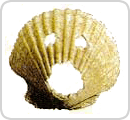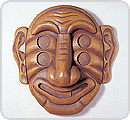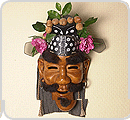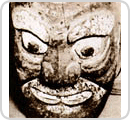|
|
|
 |
A mask is called 'Gamyeon', which
literally means 'a false face'. Its
old Korean word is 'Deotboigi'. It means
'a covered look'.
'Tal' (mask) has two meanings. As in
'Talnada', it means a bad thing, a disaster
or something like that as well as 'to
remove such a bad thing'.
One of the purposes of mask plays is
to put out bad disasters. |
|
 |
|
 |
| Shellfish masks unearthed at Dongsam-dong,
Busan are assumed to have been made
around 5000 years ago in the Stone Age.
It is the oldest mask found in Korea.
People think that it was probably used
to cover the face in hunting or to appease
the souls of hunted animals in ritual
ceremonies. |
 |
|
 |
|
 |
People probably made masks first in
around B.C. 5000 in the Stone Age or
even earlier. In Korea, many shell masks
were discovered from a shell mound at
Dongsam-dong, which evidence that there
were masks in around B.C. 5000 in the
Stone Age. In a large shell, two eye
holes and a mouth hole are made. It
looks quite interesting. Even our children
friends can make it easily. Masks in
ancient time were not difficult to make.
They were made of materials that can
be easily obtained around us.
Samguksagi describes five plays in those
days. In the description is found a
title 'Daemyeon,' which is about masks.
It reads as follows:
He wears a golden mask
Holding a whip with a jingling bell,
he drives out ghosts
Short beating, long rhythm, a round
of dance
Like a phoenix flying into
Yanye is thousand miles away
Crossing over flowing sands
Yellow hair has fallen out and dusted
Buye
Happily play thanks to goodness from
birth
What animals can rival it!
Daemyeon is known to wear a golden
mask, hold a whip with a bell in his
hand and dance a frightening dance
to drive out evil spirits. It reminds
us of the dance of Malddugi or Chuibari
who teases wicked Yangban in mask
plays.
Sanye must be a play imported from
a distant foreign country. The play
refers to the lion play, in which
the lion as the king of animals expelled
evil spirits. People played it wishing
something good may happen.
In this way various mask plays have
been handed down from old times. In
some ages, mask plays were managed
by the government... In addition,
performers formed a troupe and performed
mask plays, travelling all around
the country.
|
|
 |
|
 |
1. Mask play
2. Funeral
3. Narye (a ritual for expelling evil
spirits)
4. An object of worshipping |
| |
| 1. Masks for play... |
Have you ever had a mask play with
friends? Words in mask plays are a bit
difficult to understand but they are
also interesting and humorous.
Mask plays sometimes satirize the world.
Big issues in the real world are interestingly
expressed in the stories of mask plays.
There are big issues in each age. Then
what was the biggest issue in the Chosun
Period? In the Chosun Dynasty, social
standing was very important and Yangban
was the highest class. How would the
life of people other than Yangban is?
They were oppressed by Yangban in many
ways. Thus common people made masks
and expressed their grievances by satirizing
Yangban in mask plays.
Mask plays also contain a story about
the bad conduct of a Buddhist monk.
They are satires on an apostate monk.
In the story, an old monk falls in love
with a young woman and apostatizes his
faith.
There is also a story about a family,
in which an old man keeps the second
bride or a concubine. The story is called
'a conflict between the wife and a concubine'.
These stories all show our ancestors'
gusto and satire. |
| |
| 2. Masks for funeral |
There is a mask
called ‘Bangsangsi’.
Bansangsi leads the funeral procession
and drives away evil spirits.
Man has two eyes but Bangsangsi
has four eyes, so it is known
to see evil spirits better. |
 |
|
| |
| 3.Masks for Narye
|
There is a mask used in Narye.
Narye is a ritual for driving
away evil spirits.
The mask used in Narye is, as
you know well, Cheoyong Mask.
The story about Cheoyong Mask
is 'Cheoyong's Story' in Samgukyusa.
After playing until late at
night in Seoul under the bright
moon
Come home and look at the bed
There are four legs. Two are
mine but whose are the other
two?
I lost mine! What should I do?
Very touched by Cheoyong, the
god of disease (smallpox) said,
"I will not come in if
I see the picture of your face."
Here the god of disease means
smallpox, which is also called
'Sonnimmama'. At those days,
people suffered a lot from such
a highly infectious disease
without medicine. Thus people
danced Cheoyong Dance wearing
Cheoyong Mask to drive out evil
spirits.
|
 |
|
| |
| 4. Objects of worshipping |
Then were masks used only in
play. No. There were many other
uses. First, they were used for
religious purposes. In these cases,
masks were hung up in shrines.
Some of them are masks such as
Changguissi and Somissi enshrined
in Mt. Deokmul in Gaeseong. These
masks were not worn on the face
but set up in the shrine and worshipped.
|
 |
|
|
 |
|
 |
Compared to masks in other countries,
Korean masks have unique points or outstanding
points.
Korean masks describe well the facial
expression of Korean people. Korean
masks were made after Korean people
and, likewise, African masks were made
after African people and European masks
after European people. Thus when we
Koreans see our masks we feel intimacy.
What is more, each Korean mask exhibits
vividly the personality of the figure
represented by the mask. Yangban is
Yangban-like but, from the position
of common people, it is formed into
a pockmarked or harelipped person in
order to tease Yangban. This was possible
because mask plays were not for Yangban
but for ordinary people. In this way,
mask dances are imbued with common people's
unique, humorous and satirical spirit.
(On the other hand, a figure called
Malddugi that represents themselves
is big and red, showing off its health.)
Foreign masks particularly African masks
used in plays are not so diverse as
ours. However, they have many different
uses. Masks were utilized in coming-of-age
ceremonies, making war, treating disease,
etc. On the contrary, many kinds of
mask plays have developed in Asian countries
such as China, Japan, Sri Lanka, Thailand
and Malaysia
Diverse mask plays are found in Africa
as well. Masks were created and worn
for various uses in coming-of-age
ceremonies, secret social rituals,
rituals for rain, going to war, praying
for fortune, marking heroes, expelling
diseases as performed by Songye tribe
in Zaire, etc.
|
|
 |
|
 |
| Currently masks are made by specialists
belonging to each mask dance preservation
society (registered as an important
intangible cultural asset). Masks are
made for mask dances. Masks for Bongsan
Mask Dance are made by the Bongsan Mask
Dance Preservation Society. But not
all masks are made in this way. Hahoi
masks are made by Kim Dong-pyo, Goseong
Ogwangdae masks by Lee Do-yeol, Dongrae
Yaryu masks by Cheon Jae-dong and Yangju
Byeolsandae Play masks by Yoo Han-su.
There are many other mask artists. |
|
 |
|
 |
| Because masks were usually made by
ordinary people, easily obtainable materials
were used such as gourds, paper, wood
and straw. Masks were shaped, taking
the advantages of each material to the
full. The appearance of Yangban was
created from common people's view.
Because it came out of common people's
idea, Yangban's face is small, white,
powerless and feeble.
On the contrary, Malddugi and Chuibari
that represent common people were
made big and red, indicating that
they are healthy and strong.
|
|
